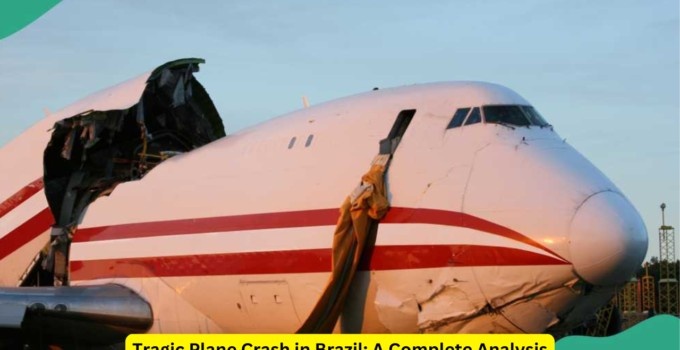
On 2024, Brazil was rocked by a tragic plane crash that claimed the lives of several passengers. This catastrophic event has raised numerous questions about aviation safety, the causes behind such incidents, and the measures that can be taken to prevent them in the future. As we delve into the details of this heartbreaking incident, it is imperative to understand the sequence of events that led to the crash, the response from authorities, and the broader implications for the aviation industry in Brazil and worldwide.
Understanding the Sequence of Events
The plane, a [model of the aircraft], was en route from [departure city] to [destination city] when it encountered severe difficulties. According to initial reports, the aircraft began experiencing technical issues approximately [number] minutes into the flight. Despite the crew’s best efforts to manage the situation, the plane eventually lost altitude and crashed in a remote area near [location of the crash].
Eyewitnesses reported seeing the aircraft descending rapidly before disappearing from sight. Emergency services were quickly dispatched to the scene, but due to the remote location and challenging terrain, reaching the crash site proved difficult. The wreckage was discovered [number] hours later, with no survivors among the passengers and crew.
Investigating the Causes
The exact cause of the crash is still under investigation, but preliminary reports suggest a combination of mechanical failure and adverse weather conditions may have played a role. The Brazilian aviation authorities, in collaboration with international experts, are conducting a thorough investigation to determine the factors that led to this tragedy. Black box data from the aircraft is being analyzed, and a detailed report is expected to be released in the coming months.
Mechanical Failure
One of the primary areas of investigation is the possibility of mechanical failure. The aircraft involved in the crash had undergone routine maintenance just weeks before the incident, raising questions about the thoroughness of these checks. Experts are examining whether any critical components were overlooked or if there was a fault that went undetected.
Weather Conditions
Another significant factor under consideration is the weather conditions at the time of the crash. The region was experiencing [description of weather conditions, e.g., severe thunderstorms, heavy rainfall] when the plane went down. Pilots are trained to navigate through adverse weather, but in some cases, extreme conditions can overwhelm even the most experienced crew.
Human Error
While mechanical failure and weather conditions are leading theories, the possibility of human error cannot be ruled out. Investigators are reviewing the actions of the flight crew during the critical moments leading up to the crash. This includes analyzing communication between the pilots and air traffic control, as well as the decisions made in response to the aircraft’s difficulties.
Response from Authorities
In the aftermath of the crash, the Brazilian government and aviation authorities have pledged to conduct a full and transparent investigation. The goal is not only to determine the cause of the crash but also to implement measures that will prevent similar incidents in the future.
Search and Rescue Operations
The search and rescue operations were hampered by the remote location of the crash site and the challenging weather conditions. Nevertheless, emergency services worked tirelessly to reach the wreckage as quickly as possible. Unfortunately, the severe impact of the crash left no survivors. The bodies of the victims have been recovered and are being identified by forensic teams, a process that is expected to take several weeks due to the condition of the remains.
Support for the Victims’ Families
The Brazilian government has also extended its condolences to the families of the victims and is providing them with support during this difficult time. This includes financial assistance for funeral arrangements and counseling services to help them cope with their loss. The airline involved in the crash has issued a statement expressing deep sorrow and is cooperating fully with the investigation.
Implications for the Aviation Industry
This tragic incident has far-reaching implications for the aviation industry, both in Brazil and internationally. It serves as a stark reminder of the importance of stringent safety protocols, regular maintenance checks, and comprehensive training for flight crews. The findings of the investigation will likely lead to changes in how aircraft are maintained and how pilots are trained to handle emergencies.
Review of Safety Protocols
In response to the crash, aviation authorities around the world are likely to review their safety protocols. This could include more rigorous inspections of aircraft, especially older models, and the implementation of new technologies to detect and prevent mechanical failures before they lead to disasters.
Impact on Airline Industry in Brazil
For the Brazilian airline industry, this crash could have significant repercussions. The airline involved may face lawsuits from the victims’ families, and its reputation could suffer long-term damage. Additionally, there may be increased scrutiny on all airlines operating within Brazil, leading to stricter regulations and oversight.
Global Aviation Standards
On a global scale, this crash will contribute to the ongoing conversation about aviation safety standards. International bodies like the International Civil Aviation Organization (ICAO) may use the findings from this investigation to update global standards and recommendations for airlines and aviation authorities.
Conclusion
The plane crash in Brazil is a tragedy that has left a deep impact on the nation and the global aviation community. As investigations continue, it is essential to learn from this incident to prevent future tragedies. The findings will not only bring closure to the families of the victims but also ensure that flying remains one of the safest modes of transportation.
Recent Comments

Macaroni Cheese Recall: Health Alert Issued for Contaminated Products

iPhone 16 Pro Max Price in Canada: What to Expect

CNN Expands Global Reach with Strategic Innovations

Kamala Harris: Shaping the Future of U.S. Politics

Amelia Bond Net Worth 2024 (Latest)

Warwick Davis Net Worth: Exploring the Life and Fortune of a Legendary Actor



